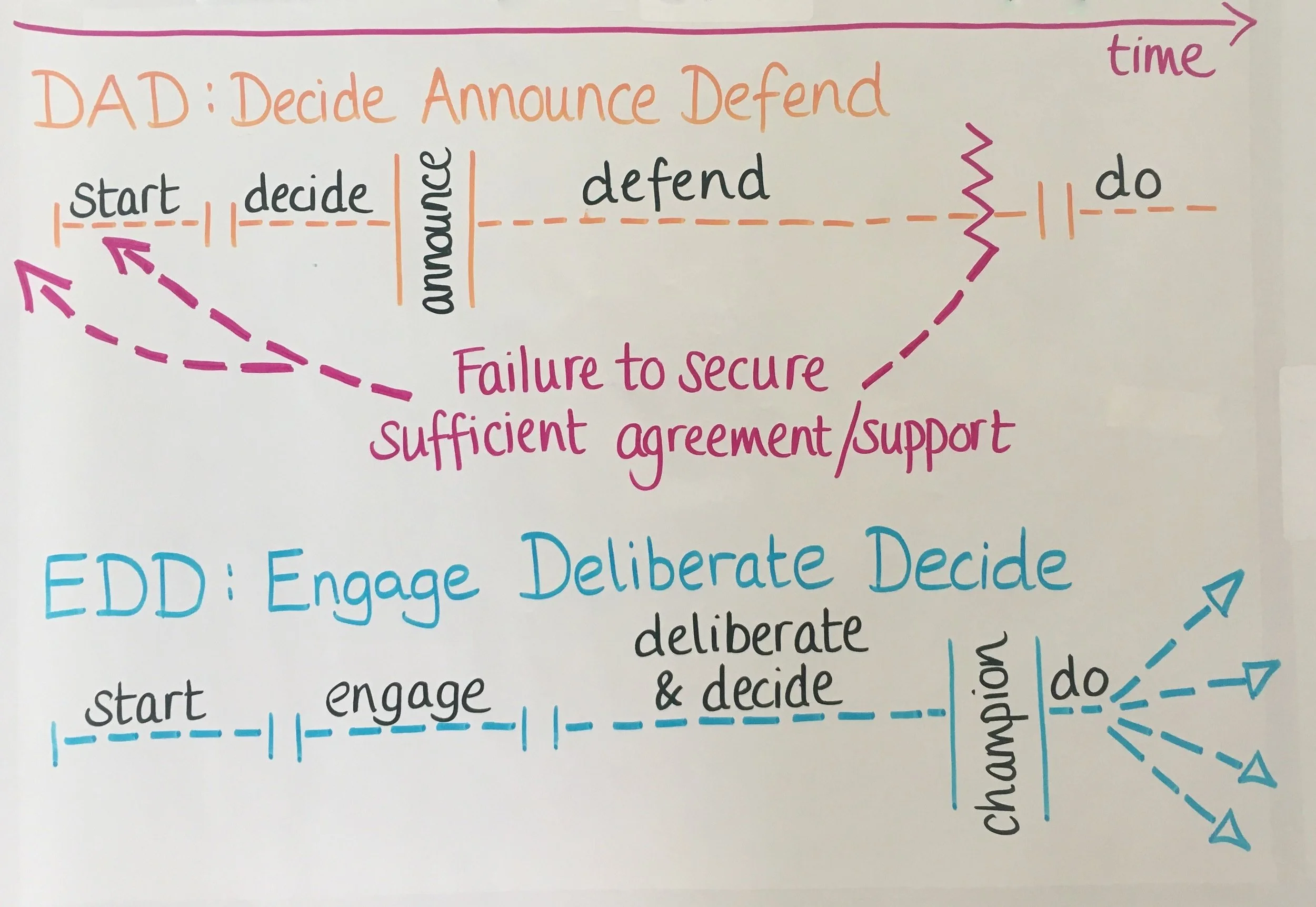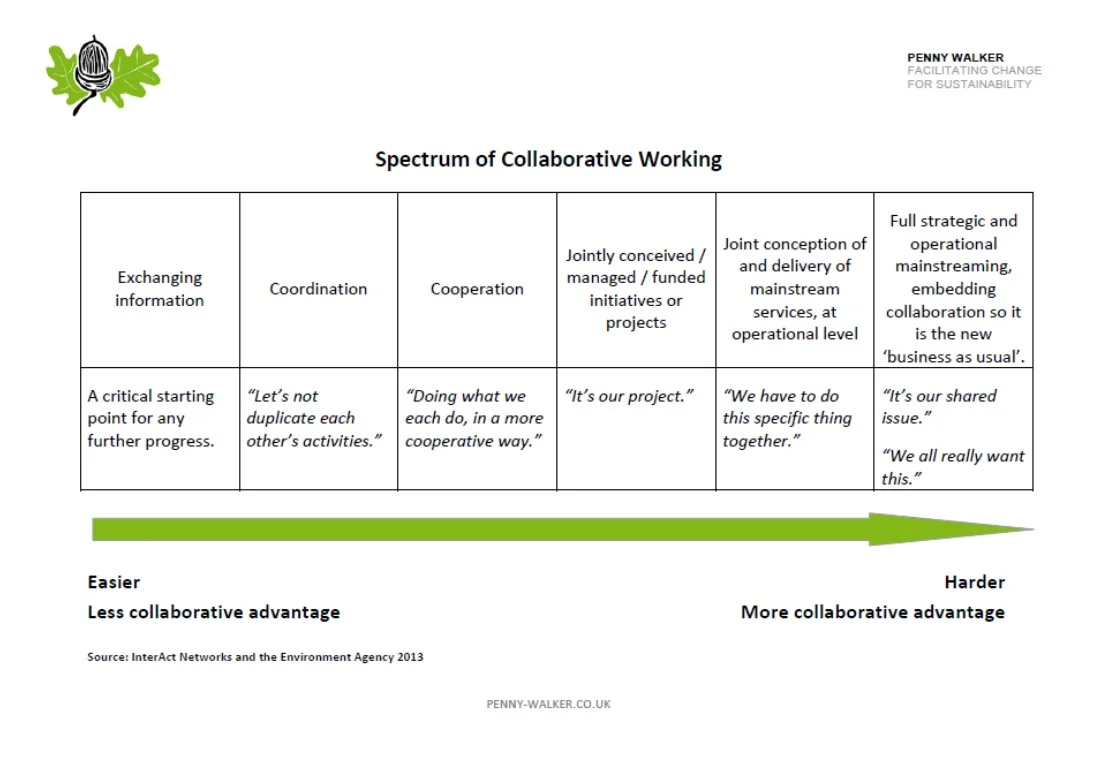For over fifteen years, InterAct Networks worked to put stakeholder and public engagement at the heart of public sector decision-making, especially through focusing on capacity-building in the UK public sector. This work - through training and other ways of helping people learn, and through helping clients thinks about structures, policies and organisational change - helped organisations get better at strategically engaging with their stakeholders to understand their needs and preferences, get better informed, collaboratively design solutions and put them into practice. Much of that work has been with the Environment Agency, running the largest capacity-building programme of its kind.
History
InterAct Networks was registered as a Limited Liability Partnership in February 2002.
Founding partners Jeff Bishop, Lindsey Colbourne, Richard Harris and Lynn Wetenhall established InterAct Networks to support the development of 'local facilitator networks' of people wanting to develop facilitation skills from a range of organisations in a locality.
These geographically based networks enabled cross organisational learning and support. Networks were established across the UK, ranging from the Highlands and Islands to Surrey, Gwynedd to Gloucestershire. InterAct Networks provided the initial facilitation training to the networks, and supported them in establishing ongoing learning platforms. We also helped to network the networks, sharing resources and insights across the UK. Although some networks (e.g. Gwynedd) continue today, others found the lack of a 'lead' organisation meant that the network eventually lost direction.
In 2006, following a review of the effectiveness of the geographical networks, InterAct Networks began working with clients to build their organisational capacity to engage with stakeholders (including communities and the public) in decision making. This work included designing and delivering training (and other learning interventions), as well as setting up and supporting internal networks of engagement mentors and facilitators. We have since worked with the Countryside Council for Wales, the UK Sustainable Development Commission, Defra, DECC (via Sciencewise-ERC see p10), Natural England and primarily the Environment Agency in England and Wales.
Through our work with these organisations InterAct Networks led the field in:
After Richard and Jeff left, Penny Walker joined Lindsey and Lynn as a partner in 2011, and InterAct Networks became limited company in 2012. In 2014, Lynn Wetenhall retired as a Director.
Some insights into building organisational capacity
Through our work with clients, especially the Environment Agency, we have learnt a lot about what works if you want to build an organisation's capacity to engage stakeholders and to collaborate. There is, of course, much more than can be summarised here. Here are just five key insights:
- Tailor the intervention to the part of the organisation you are working with.
- For strategic, conceptual 'content', classroom training can rarely do more than raise awareness.
- Use trainers who are practitioners.
- Begin with the change you want to see.
- Learning interventions are only a small part of building capacity.
Tailor the intervention
An organisation which wants to improve its engagement with stakeholders and the public in the development and delivery of public policy needs capacity at organisational, team and individual levels.
This diagram, originated by Jeff Bishop, shows a cross-organisational framework, helping you to understand the levels and their roles (vision and direction; process management; delivery). If capacity building remains in the process management and delivery zones, stakeholder and public engagement will be limited to pockets of good practice.
Classroom training will raise awareness of tools
There are half a dozen brilliant tools, frameworks and concepts which are enormously helpful in planning and delivering stakeholder and public engagement. Classroom training (and online self-guided learning) can do the job of raising awareness of these. But translating knowledge into lived practice - which is the goal - needs ongoing on-the-job interventions like mentoring, team learning or action learning sets. Modelling by someone who knows how to use the tools, support in using them - however inexpertly at first - and reinforcement of their usefulness. Reflection on how they were used and the impact they had.
Use trainers who are practitioners
People who are experienced and skillful in planning and delivering stakeholder and public engagement, and who are also experienced and skillful in designing and delivering learning interventions, make absolutely the best capacity-builders. They have credibility and a wealth of examples, they understand why the frameworks or skills which are being taught are so powerful. They understand from practice how they can be flexed and when it's a bad idea to move away from the ideal. We were enormously privileged to have a great team of practitioner-trainers to work with as part of the wider InterAct Networks family.
Begin with the change you want to see
The way to identify the "learning intervention" needed, is to begin by asking "what does the organisation need to do differently, or more of, to achieve its goals?", focusing on whatever the key challenge is that the capacity building needs to address. Once that is clear (and it may take a 'commissioning group' or quite a lot of participative research to answer that question), ask "what do (which) people need to do differently, or more of?". Having identified a target group of people, and the improvements they need to make, ask "what do these people need to learn (knowledge, skills) in order to make those improvements?". At this stage, it's also useful to ask what else they need to help them make the improvements (permission, budget, resources, changes to policies etc). Finally, ask "what are the most effective learning interventions to build that knowledge and those skills for these people?". Classroom training is only one solution, and often not the best one.
Learning interventions are (only) part of the story
Sometimes the capacity that needs building is skills and knowledge - things you can learn. So learning interventions (training, coaching, mentoring etc) are appropriate responses. Sometimes the capacity "gap" is about incentives, policies, processes or less tangible cultural things. In which case other interventions will be needed. The change journey needs exquisite awareness of what 'good' looks like, what people are doing and the impact it's having, what the progress and stuckness is. Being able to share observations and insights as a team (made up of both clients and consultants) is invaluable.
The most useful concepts and frameworks
Over the years, some concepts and frameworks emerged as the most useful in helping people to see stakeholder engagement, collaboration and participation in a new light and turn that enlightenment into a practical approach.
I've blogged about some of these elsewhere on this site: follow the links.
- What's up for grabs? What's fixed, open or negotiable.
- Asking questions in order to uncover latent consensus - the PIN concept.
- How much engagement? Depending on the context for your decision, project or programme, different intensities of engagement are appropriate. This tool helps you decide.
- Is collaboration appropriate for this desired outcome? This matrix takes the 'outcome' that you want to achieve as a starting point, and helps you see whether collaborating with others will help you achieve it.
- Engagement aims: transmit, receive and collaborate. Sometimes known as the Public Engagement Triangle, this way of understanding "engagement aims" was developed originally by Lindsey Colbourne as part of her work with the Sciencewise-ERC, for the Science for All Follow Up Group.
- Who shall we engage and how intensely? (stakeholder identification and mapping)
Three-day facilitation training
As part of this wider suite of strategic and skills-based capacity building, InterAct Networks ran dozens of three-day facilitation skills training courses and helped the Environment Agency to set up an internal facilitator network so that quasi-third parties can facilitate meetings as part of public and stakeholder engagement. The facilitator network often works with external independent facilitators, contracted by the Environment Agency for bigger, more complex or higher-conflict work. This facilitation course is now under the stewardship of 3KQ.
More reports and resources
Here are some other reports and resources developed by the InterAct Networks team, sometimes while wearing other hats.
Evaluation of the use of Working with Others - Building Trust for the Shaldon Flood Risk Project, Straw E. and Colbourne, L., March 2009.
Departmental Dialogue Index - developed by Lindsey Colbourne for Sciencewise.
Doing an organisational stocktake.
Organisational Learning and Change for Public Engagement, Colbourne, L., 2010, for NCCPE and The Science for All group, as part of The Department of Business, Innovation and Skills (BIS)’ Science and Society programme.
Mainstreaming collaboration with communities and stakeholders for FCERM, Colbourne, L., 2009 for Defra and the Environment Agency.
Thank you for a wonderful ride
In 2015, Lindsey and Penny decided to close the company, in order to pursue other interests. Lindsey's amazing art work can be seen here. Penny continues to help clients get better at stakeholder engagement, including through being an Associate of 3KQ, which has taken ownership of the core facilitation training course that InterAct Networks developed and has honed over the years. The Environment Agency continues to espouse its "Working with Others" approach, with great guidance and passion from Dr. Cath Brooks and others. Colleagues and collaborators in the work with the Environment Agency included Involve and Collingwood Environmental Planning, as well as Helena Poldervaart who led on a range of Effective Conversations courses. We hope that we have left a legacy of hundreds of people who understand and are committed to asking great questions and listening really well to the communities and interests they serve, for the good of us all.







